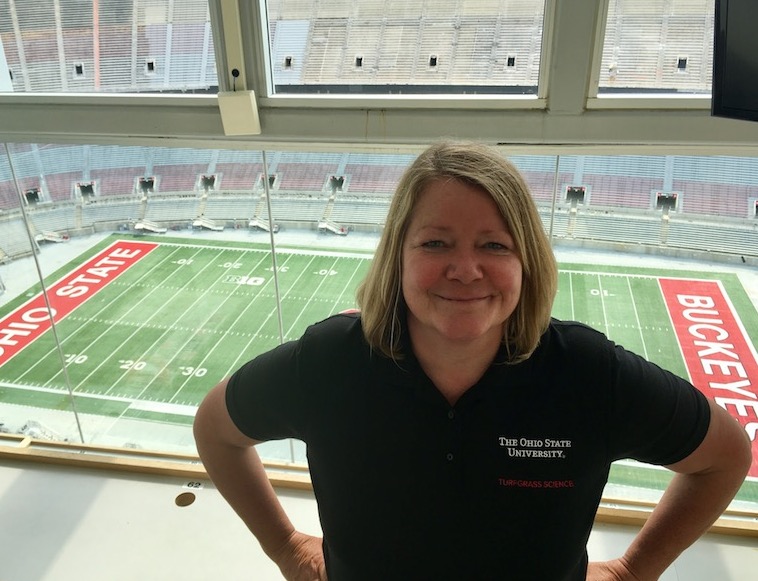Q: A new community baseball field is being built and seeded this summer. We would like to seed with 100% Kentucky bluegrass. What are some of the challenges we might encounter?
A: Kentucky bluegrass (Poa pratensis) is a perennial cool-season turfgrass adapted to grow in temperate zones, and it can provide an excellent, hard-wearing, attractive playing surface. The biggest challenge of seeding bluegrass is its slow germination and establishment rate. Germination can take anywhere from one week to three weeks, depending upon the selected cultivars, and the speed at which is establishes depends upon the level of care it receives.
There are about 200 cultivars of bluegrass, and they can differ from each other in several ways – color, density, winter dormancy, establishment rate, wear tolerance, etc. Work with your seed supplier to make sure the cultivar blend used on the field results in high-quality turf that’s wear tolerant and establishes quickly. If it’s not critical that the final sward is 100% bluegrass, adding up to 20% of a quick-germinating species such as perennial or tetraploid ryegrass to the mix will result in quicker establishment than bluegrass alone.
Closely monitoring the grow-in, and supplying adequate water and fertilizer results in quicker establishment than going with a lean-and-mean approach. I’ve had success with establishing bluegrass, deeming it “ready for play” in as little as seven weeks, but the grow-in was a strict regime of syringing every couple of hours until it had germinated, followed by applications of starter fertilizer and constant mowing. Mowing frequently (every few days once it’s well rooted) helps to promote tillering, resulting in denser turf.
If environmental conditions are conducive for seedling diseases such as pythium, using a fungicide-coated seed offers protection against disease. Applying a liquid or granular fungicide at seeding can also provide beneficial, non-target effects on turf health. I have seen this result in several summer studies, where the fungicide has resulted in darker, denser turf with greater tissue nitrogen than control plots that did not receive any fungicide protection.
The most important key to bluegrass establishment, since it’s so slow, is to control weeds that can quickly out-compete the bluegrass if not checked. This is the number-one reason bluegrass renovations fail – especially in late spring when weed pressure is so high. Crabgrass, yellow nutsedge, etc., will grow in quickly and crowd out the new bluegrass seedling; so it’s critical that weed control be a part of the bluegrass renovation process. A pre- and post-emergence herbicide such as mesotrione can be used safely at the time of seeding without adversely affecting the bluegrass.
If your field users do not allow the use of pesticides on the field, there are a couple of options. A new technique I learned of recently was to use a cover crop such as white mustard as a biofumigant (a natural organic soil fumigant). Several weeks before the bluegrass seeding takes place, the white mustard crop is grown on site. At the early flower stage, the crop is chopped down with a flail mower and the plant material tilled into the top five inches of topsoil, and then watered in. This results in a natural organic fumigation of the soil, helping to prevent/control insect pests and weed seeds. The flowering mustard plants are beneficial to pollinators, and, once tilled in, add organic matter to the soil. The use of white mustard as a cover crop for biofumigation could be a very helpful strategy for turf managers who cannot control pests and weeds with pesticides.
Another option to minimize weed competition would be to use bluegrass sod instead of seed. Sod provides a full stand of turf, and is a great way to get 100% bluegrass established on the field quickly. Additional tools that help with establishment, such as using growth blankets and using plant growth regulators to promote tillering are also worth investigating.
Lastly, one of the key components to success with a bluegrass seeding is turf expertise. Bluegrass is a high-quality, high-maintenance grass that needs to be managed by someone who has turf experience. That’s why perennial ryegrass is used so much on athletic fields, because it’s quick and easy. Good luck in your endeavor. A new bluegrass field is a thing of beauty, and worth the extra effort to get it established.
Pamela Sherratt
Sports turf extension specialist
The Ohio State University
Questions?
Send them to Pamela Sherratt at 202D Kottman Hall, 2001 Coffey Road, Columbus, OH 43210 or sherratt.1@osu.edu
Or send your question to Dr. Grady Miller, North Carolina State University, Box 7620, Raleigh, NC 27695-7620, or grady_miller@ncsu.edu


